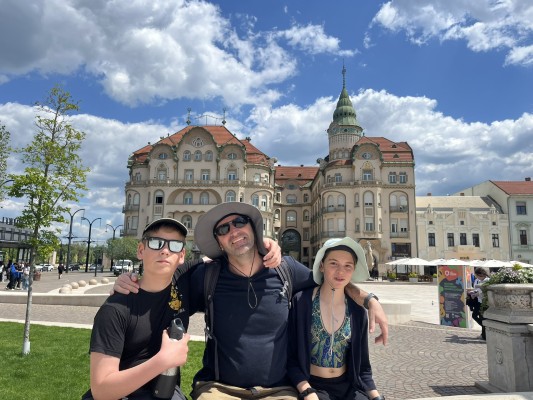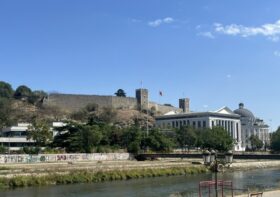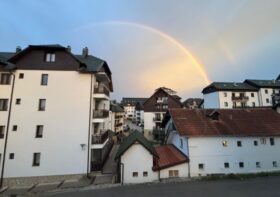Oradea & Cluj-Napoca, Romania

After Budapest, we headed east and spent a week in the border town of Oradea and 2 weeks in Romania’s second largest city: Cluj-Napoca.
Oradea
This town (pronounced Oh-RAH-dia) is right on the border with Hungary and has been an important city throughout history. It was inhabited by just about everyone – Celts, Dacians, Romans, Ottomans, Germans, Hungarians and Soviets.
Oradea is putting a lot of money into restoring their beautiful town and the historic center is now a pleasure to walk around. There is a small river that separates the town and there is an older citadel on one end of the town.
We stayed in a modern apartment near a huge shopping center on the 10th floor. The view from our balcony was amazing and we spent most evenings and mornings sitting on the balcony sipping coffee/wine and enjoying the view. As the sun set, the golden crosses on the tops of the churches glowed.
Here are some photos of Oradea:



























Cluj-Napoca
Cluj is the second largest city in Romania (after Bucharest) and is the capital of Transylvania. It was also inhabited by the Dacians, the Romans, the Hungarians and the Ottomans. We stayed in a cottage on the outskirts of town next door to the owner’s house who had a fabulous garden. The place was very calm and peaceful.


We choose to stay in Cluj because of the cheap flights from its airport as we needed to take a couple of short trips for administrative (and orthodontic) purposes.
The historic center was kind of cute – a large section of the old wall still surrounds part of the town, and there were several cafes near the main cathedral and nearby pedestrian streets.























We caught up with some friends one night for dinner and afterwards they took us to an ice-cream shop where they recommended the popcorn ice cream – but none of us were brave enough to try it! I’m not sure I really understand this country’s obsession with popcorn (which is strange coming from me) but I also wasn’t brave enough to try the popcorn chocolate…

Cluj was also home to the scariest church I’ve ever been in – the Orthodox Cathedral. From the outside, it looks like a nice orthodox church… It was very dark with a fairly ornate silver altar. It also had 2 side rooms and off of these side rooms were two very, very dark chambers where only flickering candles barely lit the room and the vent in the ceiling made creepy noisy. It was the perfect set up for where you should place Dracula’s coffin. I didn’t last long and ran out of there! Unfortunately the photos didn’t really turn out because it was so dark.








Salina Turda
We took a day trip to this unique place. It has been a salt mine since Roman times. Mining stopped in the 1930s and during WWII, it was used as a shelter and hospital. In the 1990s, a private company bought the mine and had the strange idea to turn it into an amusement park.
Upon entering the mine, you need to walk down about 120 steps and then a long hallway and then another set of stairs to get to the main chamber. From there, you can choose to either take the stairs or glass elevator down 13 flights to the middle level. R took the stairs down, but when the kids and I looked at the beams holding up the walking path over the drop, we were terrified and decided on the elevator. I’m not normally scared of heights or confined spaces, but this terrified me. My heart was pounding as I stepped into the elevator!
Once you get to the middle level – you will find a souvenir shop, a ferris wheel, mini golf and pool tables. You can then walk or take the lift down another 13 flights to get to the salt pool where you could rent a boat and paddle around the pool.
The salt cristals covering the walls, floor, bannisters and absolutely everything else was really cool! I’ve never been in a salt mine before and it was definitely a unique experience.



















Next stop – Sibiu to attend another pop-up hub.
Discover more from Kids Travel World
Subscribe to get the latest posts sent to your email.




Leave a Reply